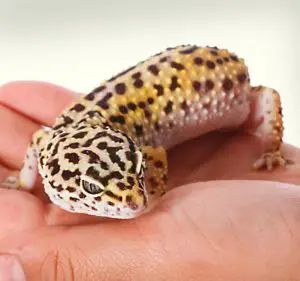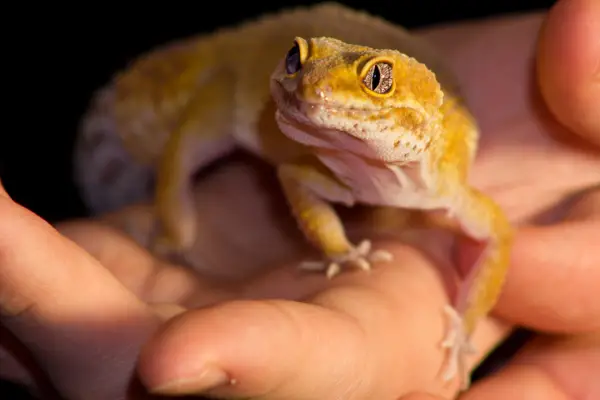Leopard geckos are such interesting creatures. Native to arid places like India and Pakistan, they can reach a length of up to ten inches for females, and 12 inches for males. They can live up to 20 years so, over their lifetime, females can lay a lot of eggs.
So, how many eggs does a leopard gecko lay? The short answer is that a mature leopard gecko can lay between 8 and 10 eggs per clutch. This is less for their first clutch where they might only lay one or two. Let’s look in more detail about leopard gecko eggs and breeding.
How many clutches of eggs do leopard geckos lay per year and how many eggs does a leopard gecko lay?
When a breeding season has begun, female leopard geckos will lay a clutch of eggs regularly at least every 22 days but it can be every 15 days.
How many eggs does a leopard gecko lay and how long does hatching take? It takes between 16 and 22 days for the female to lay her eggs after mating. The breeding season lasts between four and five months and during their first year of breeding females can lay between eight and ten eggs. After this first year, they will lay more.
How many eggs does a leopard gecko lay and when? Female geckos aged between 2 and 5 years old will produce one or two eggs at a time, which might result in between four and ten clutches (10 to 15 eggs) each season. Some females, though, might only lay two or three clutches per year.
You shouldn’t really allow a female leopard gecko to breed after the age of six due to how much pressure it will put her under.
How many eggs does a leopard gecko lay in their life? Over their lifetime, leopard geckos might lay up to 100 eggs.

How many eggs does a leopard gecko lay?
Can you tell if a leopard gecko egg is fertilised?
Leopard gecko egg candling is similar to the practice done by chicken breeders. When deciding if an egg has been fertilised you can shine a light (a torch, for example) on the egg to see if the egg looks red or pink on the inside. If it does, this is an indication that there is a baby leopard gecko growing inside it.
Eggs that have not been fertilised will have no red or pink hue and will instead look more yellow inside. However, you never know so it’s always best to incubate until you see the egg deflating, growing mould, or smelling bad.
Some leopard gecko breeders will take the eggs out of the incubator to candle them but it is always best to leave them alone. The more you disturb an egg, the less chance of hatching it will have.
This is because by taking it out, you will expose it to a different temperature and humidity. With some skill, it is possible to candle leopard gecko eggs without taking them out of the incubator.
How long does it take for a leopard gecko egg to hatch?
Leopard gecko incubation period varies considerably and it depends on the incubator temperature and humidity. Eggs can hatch in as little as 35 days or they can take anywhere up to 89 days.
You should always allow the hatching process to happen naturally and you should not intervene in any way. Typically, gecko eggs won’t take long to hatch. It’s possible that you’ll look one day and have no hatchlings but then have lots the next day.
Normally, you won’t witness the eggs hatching because the process is very quick. It’s more likely that you’ll look in the incubator and see some babies in there. If you do manage to see them hatch, it’s a great experience! But, remember not to intervene.
How do you take care of leopard gecko eggs?
First of all, you need to make sure there is a nice space for your female to lay her eggs. You should provide a box specifically for egg-laying. It needs to be between 6 and 7 inches across and 4 inches high. If you have between three and five females, a shoebox-size plastic box is a good egg-laying box.
All females will lay their eggs in the same box. The box should have a hole in the lid so that the females can get in and out. It should be carefully filled with moist vermiculite or peat moss or litter.
Whatever you use, you need to make sure it feels like earth while ensuring it isn’t too wet.
When your females have laid their eggs, you need to incubate them. Eggs can be incubated in plastic shoe boxes or deli cups that are filled with perlite or vermiculite up to 2 inches deep.
You should make sure the moisture levels are ideal by mixing equal parts of water to incubation medium (by weight instead of volume).
The eggs should be slightly buried and separated by at least one half of an inch. There should be a tight-fitting lid with between five and ten air holes the size of a pushpin at the top.
If you notice that the leopard gecko eggs have some dents in while they are incubating them, then you need to spray the egg container (not the eggs) with water between four and five times.
The temperature at which the eggs are incubated determines what sex the leopard geckos will be. If the eggs are incubated at 80°F then all of them will hatch as females. At 87°F, there will be an equal number of females and males, and at 90°F, 98” of the leopard gecko hatchlings will be male. You should never have the hatchlings at a temperature below 74°F as this can be lethal.
You can read more about the temperature leopard geckos need in my leopard gecko care guide.
If you would like to purchase an incubator instead of making one, this is possible too. However, you should always place leopard gecko eggs in their incubator with moisture and substrate, otherwise, they will shrivel and turn raisin-like.
If you are interested in buying a reptile egg incubator this one available to buy from Amazon by Zoo Med would be perfect.
What should you feed your breeding leopard geckos?
Leopard geckos need extra attention when they’re breeding. They should be provided with crickets three or four times a week and there should always be a source of mealworms in the gecko’s enclosure. Any insects given shouldn’t be longer than your leopard gecko’s head and they shouldn’t be thicker than half of the width.
Giving your leopard gecko a balanced diet is essential and you should gut load your insects with hog or chick mash for 24 to 48 hours before you let your leopard geckos eat them.
Breeding leopard geckos also need to have extra vitamin D3 and calcium. You can provide a small bowl of supplements in one corner of its cage so that they can decide how much they want to eat.
Fresh water should be provided in a sturdy, shallow dish with a diameter of between three and six inches.
How should you care for hatchling leopard geckos?
Until the newborns are around seven inches in length, they should be raised alone in a shoebox-sized container. They need access to food, water, heat and shelter. Juveniles require the temperature to be around 90°F at one end with a cool end that is the same temperature as an adult’s enclosure (73°F). The floor covering can be as simple as paper towels.
After around three days, leopard geckos will shed their skin and start eating. At this time, it’s best to offer one-inch mealworms. They should be provided with between five and ten mealworms every two days.
Final thoughts
How many eggs does a leopard gecko lay? It’s not too difficult to breed leopard geckos but it’s a bit more challenging than just putting one male and one female together. Leopard geckos only breed when specific conditions are met so you will need to ensure you provide the best environment and set up if you want to breed them
